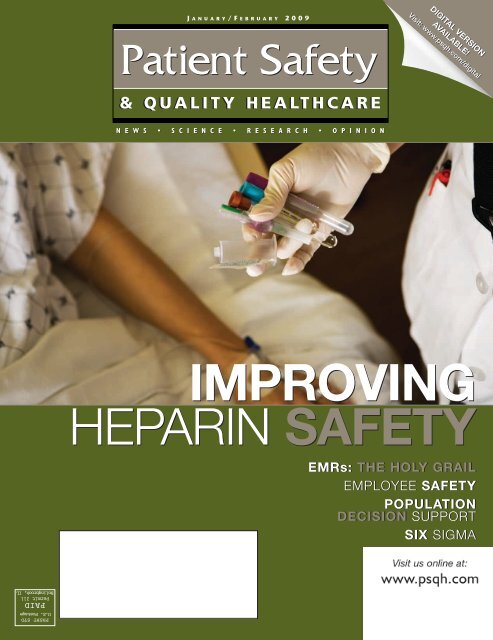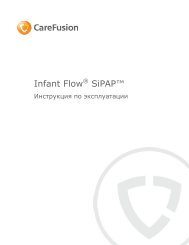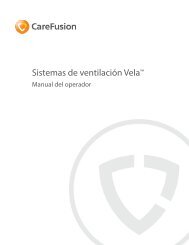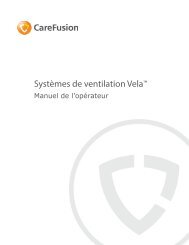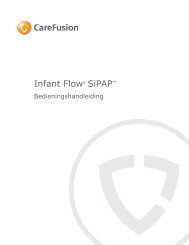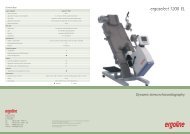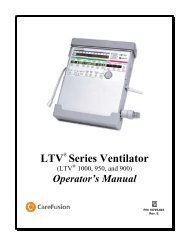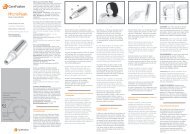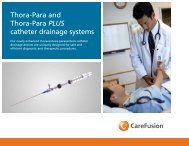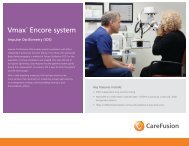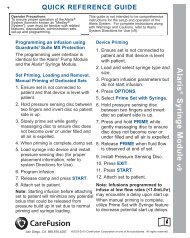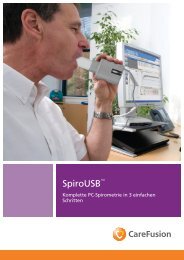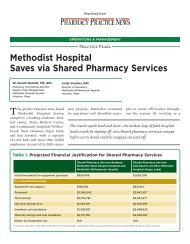Heparin: Improving Treatment and Reducing Risk of ... - CareFusion
Heparin: Improving Treatment and Reducing Risk of ... - CareFusion
Heparin: Improving Treatment and Reducing Risk of ... - CareFusion
You also want an ePaper? Increase the reach of your titles
YUMPU automatically turns print PDFs into web optimized ePapers that Google loves.
DIGITAL DIGITAL VERSION VERSION<br />
J A N U A R Y/F E B R U A R Y 2009<br />
Visit: Visit: www.psqh.com/digital<br />
www.psqh.com/digital<br />
AVAILABLE!<br />
AVAILABLE!<br />
Patient Safety<br />
& QUALITY HEALTHCARE<br />
N E W S • S C I E N C E • R E S E A R C H • O P I N I O N<br />
IMPROVING<br />
HEPARIN SAFETY<br />
EMRs: THE HOLY GRAIL<br />
EMPLOYEE SAFETY<br />
POPULATION<br />
DECISION SUPPORT<br />
SIX SIGMA<br />
PRSRT STD<br />
U.S. Postage<br />
PAID<br />
Permit 211<br />
Bolingbrook, IL
HEPARIN:IMPROVING TREATMENT AND<br />
<strong>Reducing</strong> <strong>Risk</strong><br />
<strong>of</strong> Harm<br />
Clinical, Laboratory <strong>and</strong> Safety Challenges<br />
T<br />
he short-acting, reversible<br />
anticoagulant heparin is<br />
widely used in hospitalized<br />
patients to prevent<br />
the development or extension <strong>of</strong><br />
potentially life-threatening blood<br />
clots. However, numerous issues<br />
make the use <strong>of</strong> this high-risk agent<br />
particularly challenging <strong>and</strong> errorprone.<br />
As shown by media reports<br />
<strong>of</strong> heparin-related infant deaths<br />
<strong>and</strong> injury in Indiana, California,<br />
<strong>and</strong> Texas, heparin-related medication<br />
errors can have devastating<br />
impact on patients, families, staff,<br />
<strong>and</strong> the reputation <strong>of</strong> a healthcare<br />
institution <strong>and</strong> its leadership.<br />
Safe <strong>and</strong> effective use <strong>of</strong> heparin requires maintaining a delicate<br />
balance—dosing low enough to minimize the risk <strong>of</strong> bleeding,<br />
yet high enough to treat or prevent thrombosis. Achieving a<br />
therapeutic level <strong>of</strong> heparin within 24 hours significantly<br />
reduces the risk for recurrent venous thromboembolism (VTE)<br />
(Raschke et al., 1993; Hull et al., 1997; An<strong>and</strong> et al., 1996; An<strong>and</strong><br />
et al., 1999). However, non-protocol-driven practice achieves<br />
this outcome only 40% <strong>of</strong> the time (Wheeler et al., 1988).<br />
By<br />
William E. Dager, PharmD, FCSHP<br />
Robert C. Gosselin, CLS<br />
Robert Raschke, MD, MS<br />
Tim V<strong>and</strong>erveen, PharmD, MS<br />
Image Courtesy <strong>of</strong> Cardinal Health<br />
20 Patient Safety & Quality Healthcare ■ January/February 2009 www.psqh.com
Medication errors involving unfractionated heparin (UFH)<br />
are among the most common <strong>and</strong> serious in clinical practice.<br />
More than 17,000 heparin-related medication errors were<br />
reported to the U.S. Pharmacopoeia (USP) MEDMARX from<br />
2003 to 2007; 556 <strong>of</strong> these resulted in harm to patients, including<br />
seven deaths (Santell, 2008).<br />
An expert advisory panel <strong>of</strong> The Joint Commission (TJC)<br />
recognized that “anticoagulation is a high-risk treatment<br />
which commonly leads to adverse drug events because <strong>of</strong> the<br />
complexity <strong>of</strong> dosing, monitoring <strong>and</strong> patient compliance”<br />
<strong>and</strong> that “the use <strong>of</strong> st<strong>and</strong>ardized practices can reduce the risk<br />
<strong>of</strong> adverse drug events.” In 2008 TJC issued National Patient<br />
Safety Goal 3E (NPSG 3E) to “Reduce the risk <strong>of</strong> harm associated<br />
with the use <strong>of</strong> anticoagulant therapy.” Hospitals were<br />
required to be fully compliant with this goal by January 1,<br />
2009 (TJC NPSG, 2008).<br />
Key clinical, laboratory, <strong>and</strong> safety issues surrounding heparin<br />
were addressed in a nationwide webcast on “<strong>Improving</strong><br />
<strong>Heparin</strong> Safety,” hosted by the Center for Safety <strong>and</strong> Clinical<br />
Excellence on July 11, 2008. In this article, we summarize<br />
important information <strong>and</strong> recommendations, focusing on the<br />
three stages <strong>of</strong> heparin use that account for 67% <strong>of</strong> heparinrelated<br />
errors—dosing, monitoring <strong>and</strong> administration (Santell,<br />
2008).<br />
Dosing<br />
Significant errors in dosing heparin <strong>and</strong> interpreting reported<br />
aPTT values can result from unnecessary variation in physician<br />
practice. St<strong>and</strong>ardized protocols for dosing heparin can help<br />
reduce such variability. Although physicians sometimes are perceived<br />
as being resistant to change, in fact they are more resistant<br />
to having change m<strong>and</strong>ated. For this reason, prescribers need to<br />
participate in the development <strong>and</strong> adoption <strong>of</strong> heparin-related<br />
st<strong>and</strong>ards, guidelines or protocols.<br />
The Deep Vein Thrombosis Prevention program at the University<br />
<strong>of</strong> California, San Diego Medical Center used a multidisciplinary<br />
consensus-building process to develop <strong>and</strong><br />
implement a st<strong>and</strong>ardized, physician-friendly, risk-assessment<br />
process <strong>and</strong> VTE-prevention order set. Results showed that<br />
appropriate VTE prophylaxis increased from 55% to over 95%<br />
<strong>of</strong> patients <strong>and</strong> was accompanied by a documented decrease in<br />
thromboembolic events (Peterson et al., 2008).<br />
Approaches to initiating heparin infusion to reach targets<br />
were also reviewed. A study by<br />
Raschke et al. showed that compared<br />
to a st<strong>and</strong>ard, “one-size-fitsall,”<br />
initial heparin dosing scheme, a<br />
weight-based protocol increased the<br />
percent <strong>of</strong> patients within the therapeutic<br />
range within 24 hours from<br />
77% to 97% (p=0.002) <strong>and</strong> significantly<br />
reduced the risk <strong>of</strong> recurrent<br />
venous thromboembolism (RR 0.2,<br />
p=0.02). The incidence <strong>of</strong> bleeding<br />
complications was the same in both<br />
groups, despite more aggressive dosing in the weight-based<br />
group (Raschke et al., 1993).<br />
A subsequent study showed that improvements were maintained<br />
over a 5-year period with a nearly 95% protocol implementation<br />
rate. Initial heparin infusion rates increased from<br />
1,185 to 1,420 units/hour (p
HEPARIN SAFETY<br />
changes its thromboplastin reagent <strong>and</strong> can go in either direction.<br />
Failure to account for such change by updating heparin<br />
dosing schemes would have resulted in systematic underdosing<br />
<strong>of</strong> the vast majority <strong>of</strong> patients. For this reason, it is important<br />
that each institution adjust heparin dosing guidelines as necessary<br />
to the aPTT assay reagent currently in use.<br />
patients with lower UFH infusion rates can lead to underestimation<br />
<strong>of</strong> UFH anticoagulation. The presence <strong>of</strong> a heparin<br />
effect may not be appreciated because the ACT test is not<br />
designed to measure effects in the lower target range. Thus,<br />
while POC testing devices provide rapid results, such devices<br />
may sacrifice accuracy <strong>and</strong> precision.<br />
Pre-analytical Variables<br />
Pre-analytical variables that adversely affect aPTT test results<br />
include poor phlebotomy technique, incorrect or improperly<br />
filled blood collection tubes, delays in sample testing, temperature,<br />
<strong>and</strong> inadequate sample centrifugation prior to testing.<br />
Some drugs <strong>and</strong> disease states can also affect test results (Table<br />
2). Increased levels <strong>of</strong> fibrinogen <strong>and</strong> factor VIII (both acute<br />
phase reactants) may also reduce the aPTT result, leading to<br />
“heparin resistance.”<br />
Impact <strong>of</strong> Bolus Dosing<br />
Depending on the size <strong>of</strong> a heparin bolus, it can affect aPTT values<br />
for more than 6 hours. For example, 4 hours after a 5,000-<br />
unit bolus the aPTT result may suggest adequate heparinization,<br />
but a subsequent aPTT result may show that the continuous<br />
infusion is subtherapeutic. Earlier determination <strong>of</strong> aPTT value<br />
may be <strong>of</strong> benefit to determine if a rate increase should occur if<br />
the value is low.<br />
Point-<strong>of</strong>-Care (POC) Testing<br />
Test results will vary among POC devices <strong>and</strong> typically do not<br />
match laboratory aPTT results, because <strong>of</strong> differences in the<br />
sample type, clot-detection method, <strong>and</strong> incubation period.<br />
There are also differences between ACT manufacturers <strong>and</strong> cartridge<br />
types. A different ACT test may be used depending on the<br />
desired degree <strong>of</strong> heparin effect is being followed, which can<br />
vary between methods. Use <strong>of</strong> high-dose ACT cartridges in<br />
• Preanalytical<br />
• Poor phlebotomy technique!!!!<br />
• Time <strong>and</strong> temperature (for UFH monitoring, sample should be tested<br />
within 2 hours <strong>of</strong> collection)<br />
• Centrifugation-platelet poor (300 reagent—Instrument combinations<br />
• No st<strong>and</strong>ardization <strong>of</strong> reagents (despite attempts)<br />
• Reagent variability<br />
• Phospholipid concentration<br />
• Activator type<br />
• Influences on test<br />
• Increases in factor levels-acute phase ( aPTT)<br />
• Decreases in factor levels ( aPTT)<br />
• Drug effect ( or aPTT)<br />
• Lupus anticoagulant (may aPTT)<br />
Table 2. aPTT Test Variables<br />
Anti-Xa monitoring <strong>of</strong> UFH treatment<br />
Most institutions that measure anti-Xa activity use either a clot<br />
based or a chromogenic method. While this test is more robust<br />
than the aPTT <strong>and</strong> may be less adversely affected by pre-analytical<br />
variables, test calibration variability <strong>and</strong> methodology differences<br />
can result in a wide range <strong>of</strong> anti-Xa levels reported,<br />
(CAP, 2008).<br />
Administration<br />
The most common type <strong>of</strong> heparin-related error is also the type<br />
most likely to be associated with patient harm—administration<br />
<strong>of</strong> an improper dose or quantity (Santell, 2008). Pooled data<br />
from 54 hospitals using smart IV pumps revealed that heparin<br />
was the number one drug associated with averted errors, i.e.,<br />
smart pump alerts that resulted in reprogramming. Some<br />
errors, if not averted, would have infused dosages 50- to 100-<br />
times above or below the pre-established drug-library<br />
limits.(Cardinal Health, 2008) Analysis <strong>of</strong> smart-pump data at a<br />
regional healthcare system showed that 93% <strong>of</strong> high-risk heparin<br />
errors averted by smart pump use occurred in non-criticalcare<br />
settings (Williams et al., 2006).<br />
A frequent, potentially dangerous practice involves administering<br />
bolus doses from continuous infusions, rather than<br />
preparing a loading dose or subsequent bolus dose in a separate<br />
container such as a syringe or mini-bag. Serious errors can also<br />
occur in calculating dosage changes from an initial loading dose<br />
in units/kg to continuous infusion in units/kg/hr or units/hr.<br />
Unnecessary variability in heparin<br />
concentrations, nomenclature <strong>and</strong> dosing<br />
units further increases opportunities<br />
for error. A review <strong>of</strong> smart-pump<br />
drug libraries in 207 hospitals identified<br />
14 different heparin concentrations<br />
being used in various facilities.<br />
<strong>Heparin</strong> nomenclature also varied<br />
widely, with 191 different namedescriptors<br />
(Bates et al., 2005). Data<br />
from a 54-hospital sample showed that<br />
48% <strong>of</strong> hospitals had st<strong>and</strong>ardized dosing<br />
units on units/kg/hr, 22% used only<br />
units/hr <strong>and</strong> 30% allowed either<br />
weight-based or non-weight-based<br />
dosing units. When both dosing units<br />
were available, there was a four-fold<br />
increase in smart pump alerts that led<br />
to infusion reprogramming, i.e., averted<br />
errors (Cardinal Health, 2008).<br />
To reduce opportunities for such<br />
22<br />
Patient Safety & Quality Healthcare ■ January/February 2009 www.psqh.com
errors, NPSG 3E requires hospitals to st<strong>and</strong>ardize heparin concentrations.<br />
NPSG 3E also m<strong>and</strong>ates the use <strong>of</strong> “ programmable”<br />
infusion pumps, with a strong consensus among<br />
JC advisory panel members that smart pumps should be used<br />
for all heparin infusions (Peterson et al., 2008).<br />
The introduction <strong>of</strong> barcode label scanning as a new smart<br />
pump-feature allows the manufacturer’s barcode label on a<br />
pre-mixed heparin container to be scanned <strong>and</strong> the correct<br />
drug <strong>and</strong> concentration to be automatically selected from the<br />
pump library. Connecting the pumps to the hospital’s wireless<br />
communication system allows rapid uploading <strong>of</strong> any needed<br />
drug-library changes <strong>and</strong> frequent downloading <strong>of</strong> data on<br />
averted programming errors <strong>and</strong> compliance.<br />
St. Joseph’s/C<strong>and</strong>ler Medical Center in Savannah, Georgia,<br />
has used smart infusion pumps for more than 6 years. Smart<br />
pump continuous quality improvement (CQI) data were analyzed<br />
using a unique Harm Index to determine the potential<br />
harm <strong>of</strong> averted programming errors. Results showed that heparin<br />
administration in medical/surgical units posed the highest<br />
risk <strong>of</strong> harm for all IV infusions. To address heparin safety,<br />
the hospital system st<strong>and</strong>ardized IV heparin concentrations,<br />
streamlined the dose calculation process, eliminated the need<br />
for nurses <strong>and</strong> pharmacists to calculate infusion rates, st<strong>and</strong>ardized<br />
heparin dosing units, educated providers on revised<br />
dosing protocols (Williams et al., 2006), <strong>and</strong> implemented an<br />
inpatient anticoagulation management service whereby all<br />
UFH dosing is managed by pharmacy.<br />
Special Cases<br />
<strong>Heparin</strong>-induced thrombocytopenia (HIT)<br />
HIT is an uncommon but potentially devastating complication<br />
<strong>of</strong> treatment characterized by a drop in the platelet count to <<br />
100,000/mm3 <strong>and</strong>/or to < 50% <strong>of</strong> baseline, typically after 4 to<br />
14 days <strong>of</strong> heparin or low-molecular weight heparin exposure.<br />
Two other onset patterns, delayed <strong>and</strong> rapid should also be considered<br />
(Dager et al., 2007). The decrease in platelets is due to<br />
the formation <strong>of</strong> antibodies that lead to platelet clumping. Activation<br />
<strong>of</strong> the platelets leads to a hypercoagulable state <strong>and</strong><br />
potential for thrombosis. Bleeding secondary to reduced platelet<br />
counts is rare. Failure to discontinue heparin <strong>and</strong> initiate alternative<br />
anticoagulation will result in thromboembolic complications<br />
in the majority <strong>of</strong> patients. HIT-probability nomograms<br />
can be used to assess the likelihood that a patient has HIT<br />
(Peterson et al., 2008; Janatapour et al., 2007).<br />
Pediatrics<br />
<strong>Heparin</strong> errors in the pediatric population have recently been <strong>of</strong><br />
notable concern <strong>and</strong> may be as or more common than in adults.<br />
Children vary greatly in size <strong>and</strong> weight <strong>and</strong> require different<br />
drug concentrations <strong>and</strong> dosage. Dosing in infants is particularly<br />
important, in part because there is little margin for error. Yet<br />
information on optimal drug use <strong>and</strong> how to adjust infusion or<br />
interpret laboratory data is scant, <strong>and</strong> support systems such as<br />
computerized physician order entry may be problematic. Chil-<br />
January/February 2009 ■ Patient Safety & Quality Healthcare<br />
23
HEPARIN SAFETY<br />
dren can be more difficult to monitor <strong>and</strong> <strong>of</strong>ten are unable to<br />
provide the sort <strong>of</strong> feedback that adults can. Additional commitment<br />
to children’s safety is needed at every level <strong>of</strong> the healthcare<br />
community (Peterson et al., 2008).<br />
Anticoagulation Service<br />
As shown with pharmacists, having an anticoagulation service<br />
to oversee heparin therapy has been associated with a significant<br />
reduction in death, length <strong>of</strong> stay, cost <strong>of</strong> therapy, <strong>and</strong> bleeding<br />
complications (Bond & Raehl, 2004). An effective oversight<br />
team might include the responsible physician, bedside nurse,<br />
pharmacist, <strong>and</strong> laboratory technician. Overall, good working<br />
relationships need to be fostered among clinical, pharmacy <strong>and</strong><br />
laboratory staffs, so that knowledge about heparin therapeuticrange<br />
determinations <strong>and</strong> coagulation testing is readily shared<br />
<strong>and</strong> disseminated.<br />
After a series <strong>of</strong> serious <strong>and</strong> potentially tragic heparin<br />
errors, Fairview Health Services (FHS), a fully integrated,<br />
seven-hospital health system in the Minneapolis area, conducted<br />
a formal heparin failure mode effects analysis (FMEA)<br />
<strong>of</strong> the medication management use process. Based on the<br />
FMEA results, an FHS team took a three-pronged approach<br />
to improving heparin safety. This included revised storage<br />
<strong>and</strong> distribution <strong>of</strong> heparin, use <strong>of</strong> pre-typed protocols, a<br />
heparin dosing service, improved drug checking, use <strong>of</strong> smart<br />
FURTHER INFORMATION<br />
“<strong>Improving</strong> <strong>Heparin</strong> Safety,” a recorded webcast by W. E. Dager, R.<br />
C. Gosselin, R. Raschke, <strong>and</strong> T. V<strong>and</strong>erveen, available at<br />
www.cardinalhealth.com/clinicalcenter—click on webcasts.<br />
“Implementing NPSG 3E,” a guide prepared by members <strong>of</strong> the<br />
Clinical Affairs <strong>and</strong> the Quality <strong>and</strong> Regulatory Affairs teams <strong>of</strong><br />
Cardinal Health, available at<br />
www.cardinalhealth.com/clinicalcenter—click on NPSG 3E<br />
Resources.<br />
pumps <strong>and</strong> barcoding, error detection using the anticoagulation<br />
management service, flow sheets, specialized s<strong>of</strong>tware,<br />
<strong>and</strong> incorporation <strong>of</strong> anticoagulant-reversal protocols into<br />
dosing protocols. As a result <strong>of</strong> these actions, heparin errors<br />
decreased by 42% (Peterson et al., 2008).<br />
A <strong>Heparin</strong> Error Reduction Workgroup at a large Minnesota<br />
healthcare organization examined heparin administration<br />
procedures, identified types <strong>and</strong> sources <strong>of</strong> errors, <strong>and</strong> developed<br />
solutions to reduce heparin errors. Actions taken based on<br />
human factors analysis included the revision <strong>of</strong> ambiguous protocols;<br />
use <strong>of</strong> st<strong>and</strong>ardized, more self-explanatory terminology;<br />
improved access to computers <strong>and</strong> printers; <strong>and</strong> modification <strong>of</strong><br />
the computer interface to guide users through the ordering process<br />
more smoothly. Implementation <strong>of</strong> these actions reduced<br />
heparin errors by 37.8% (Peterson et al., 2008).<br />
24<br />
Patient Safety & Quality Healthcare ■ January/February 2009 www.psqh.com
Summary<br />
While newer parenteral agents now provide preferred alternatives<br />
for anticoagulation, heparin will likely continue to play an<br />
important role in clinical situations where a shorter-acting,<br />
reversible agent is needed, e.g., when bleeding risks are high or<br />
invasive procedures require rapid adjustments in anticoagulation<br />
intensity. Implementation <strong>of</strong> safety recommendations <strong>and</strong> other<br />
measures can help to improve safety <strong>and</strong> heparin therapy, which<br />
can be expected to contribute to improved outcomes. ❙PSQH<br />
William Dager received his doctorate in pharmacy from the<br />
University <strong>of</strong> California, San Francisco (UCSF), <strong>and</strong> served his<br />
residency at the University <strong>of</strong> California, Davis Medical Center<br />
(UCDMC) in Sacramento. He also completed a Nephrology<br />
Pharmaceutical Care Preceptorship at the University <strong>of</strong> Pittsburgh,<br />
School <strong>of</strong> Pharmacy. Dager currently holds two academic positions,<br />
one as clinical pr<strong>of</strong>essor <strong>of</strong> pharmacy at UCSF School <strong>of</strong> Pharmacy<br />
<strong>and</strong> the other as a clinical pr<strong>of</strong>essor <strong>of</strong> Medicine at the UCD School <strong>of</strong><br />
Medicine. As a clinical specialist at UCDMC he is responsible for<br />
difficult cases in anticoagulation, pharmacokinetics, or other critical<br />
care related situations. He also is clinically active with the cardiology<br />
service.<br />
Dager is a fellow <strong>of</strong> the California Society <strong>of</strong> Hospital Pharmacists.<br />
He also currently serves as an instructor <strong>and</strong> regional affiliate faculty<br />
in ACLS for the American Heart Association <strong>and</strong> as chair <strong>of</strong> the<br />
Editorial Advisory Board panel on anticoagulation for the Annals <strong>of</strong><br />
Pharmacotherapy. He is also a site coordinator for the ASHP<br />
foundation anticoagulation preceptorship.<br />
Robert Gosselin is a technical coagulation specialist at the<br />
University <strong>of</strong> California, Davis Health System. He started working in<br />
the coagulation laboratory in 1977, while assigned to the U.S. Naval<br />
Hospital in San Diego. After his naval discharge, he passed the<br />
California boards to become a licensed medical technologist. He has<br />
worked in the U.C. Davis Health System department <strong>of</strong> pathology<br />
since 1988. Since that time, he has been involved in numerous<br />
research studies, focusing mainly on technical coagulation issues <strong>and</strong><br />
the impact <strong>of</strong> trauma <strong>and</strong> disease on coagulation. In 1995, he<br />
received board certification from the International Board <strong>of</strong> Clinical<br />
<strong>and</strong> Applied Hemostasis, Thrombosis <strong>and</strong> Vascular Medicine. He has<br />
authored or co-authored more than 50 peer-reviewed publications, 8<br />
distant learning courses, <strong>and</strong> currently is an active member <strong>of</strong> the<br />
International Society <strong>of</strong> Thrombosis <strong>and</strong> Hemostasis.<br />
Robert Raschke is director <strong>of</strong> critical care services at Banner Health<br />
in Phoenix, Arizona. He holds a faculty appointment at the University<br />
<strong>of</strong> Arizona as assistant pr<strong>of</strong>essor <strong>of</strong> clinical medicine. He received his<br />
master’s degree from the University <strong>of</strong> Michigan in clinical research<br />
design <strong>and</strong> medical biostatistics <strong>and</strong> is board-certified in Internal<br />
Medicine <strong>and</strong> Critical Care Medicine.<br />
Tim V<strong>and</strong>erveen is vice president <strong>of</strong> the Center for Safety <strong>and</strong><br />
Clinical Excellence. He is responsible for ensuring Cardinal Health’s<br />
commitment to education <strong>and</strong> innovation to reduce variation in<br />
clinical practice, <strong>and</strong> to supporting hospitals’ patient safety initiatives.<br />
Prior to this position, V<strong>and</strong>erveen was the director <strong>of</strong> clinical affairs,<br />
medication management systems, for ALARIS Medical Systems. He<br />
has been instrumental in the development <strong>of</strong> many <strong>of</strong> the innovations<br />
<strong>and</strong> safety <strong>and</strong> performance enhancements in drug infusion.<br />
V<strong>and</strong>erveen served a hospital pharmacy residency at Bronson<br />
Methodist Hospital in Kalamazoo, Michigan. From 1972 to1983 he<br />
was on the faculty <strong>of</strong> the College <strong>of</strong> Pharmacy at Medical University<br />
<strong>of</strong> South Carolina <strong>and</strong> was Director <strong>of</strong> the Division <strong>of</strong> Clinical<br />
Pharmacy. He also had a faculty appointment in the College <strong>of</strong><br />
Medicine <strong>and</strong> was on staff at the Charleston VA Hospital.V<strong>and</strong>erveen<br />
received his BS <strong>and</strong> MS degrees from Purdue University School <strong>of</strong><br />
Pharmacy <strong>and</strong> his PharmD degree from the Medical University <strong>of</strong><br />
South Carolina. He may be contacted at<br />
tim.v<strong>and</strong>erveen@cardinal.com.<br />
REFERENCES<br />
An<strong>and</strong>, S., Ginsberg, J. S., Kearon, C., et al. (1996). The relation<br />
between the activated partial thromboplastin time response <strong>and</strong><br />
recurrence in patients with venous thrombosis treated with<br />
continuous intravenous heparin. Archives <strong>of</strong> Internal Medicine, Aug<br />
12-26;156(15),1677-1681.<br />
An<strong>and</strong>, S. S., Bates, S., Ginsberg, J. S., et al. (1999). Recurrent venous<br />
thrombosis <strong>and</strong> heparin therapy: an evaluation <strong>of</strong> the importance<br />
<strong>of</strong> early activated partial thromboplastin times. Archives <strong>of</strong> Internal<br />
Medicine, Sep 27;159(17), 2029.<br />
Bates, D. W., V<strong>and</strong>erveen, T., Seger, D. L., et al. (2005). Variability in<br />
intravenous medication practices: implications for medication<br />
safety. Joint Commission Journal on Patient Safety <strong>and</strong> Quality,<br />
31(4), 203-210.<br />
Bond, C. A., & Raehl, C. L. (2004). Pharmacist-provided anticoagulation<br />
management in United States hospitals: death rates, length <strong>of</strong> stay,<br />
Medicare charges, bleeding complications, <strong>and</strong> transfusions. The<br />
Annals <strong>of</strong> Pharmacotherapy, 24(8), 953-963.<br />
College <strong>of</strong> American Pathologists. (2008). CGS4-A Participant<br />
Summary, College <strong>of</strong> American Pathologists, Northfield, IL.<br />
Cardinal Health CQI Consulting Services. (2008). Cardinal Health<br />
Hospital Pooled Data.<br />
Dager, W. E., Dougherty, J. A., Nguyen, P. H., Militello, M. A., & Smythe,<br />
M. A. (2007). <strong>Heparin</strong>-induced thrombocytopenia: a review <strong>of</strong><br />
treatment options <strong>and</strong> special considerations. Pharmacotherapy,<br />
27, 564-587.<br />
Dalen, J. E., & Hirsh, J. (Eds.). (1995). Fourth ACCP Consensus<br />
Conference on Antithrombotic Therapy. Chest, Oct 108 Suppl 225-<br />
522.<br />
Favaloro, E. J., Bonar, R., Sioufi, J., et al. (2005). Royal College<br />
Pathologists <strong>of</strong> Australasia Quality Assurance Program in<br />
Haematology. An international survey <strong>of</strong> current practice in the<br />
laboratory assessment <strong>of</strong> anticoagulant therapy with heparin.<br />
Pathology, 37, 234-238.<br />
Hull, R. D., Raskob, G. E., Brant, R. F., et al. (1997). Relation between<br />
the time to achieve the lower limit <strong>of</strong> the APTT therapeutic range<br />
<strong>and</strong> recurrent venous thromboembolism during heparin treatment<br />
for deep vein thrombosis. Archives <strong>of</strong> Internal Medicine, Dec 8-22,<br />
157(22), 2562-2568.<br />
Janatpour, K. A., Gosselin, R. C., Dager, W. E., et al. (2007). Usefulness<br />
<strong>of</strong> optical density values from heparin- platelet factor 4 antibody<br />
testing <strong>and</strong> probability scoring models to diagnose heparin-induced<br />
thrombocytopenia. American Journal <strong>of</strong> Clinical Pathology, 127,<br />
429-433.<br />
Owings, J., Bagley, M., Gosselin, R., et al. (1996). Effect <strong>of</strong> critical injury<br />
on plasma antithrombin activity: Low antithrombin levels are<br />
associated with thromboembolic complications. The Journal <strong>of</strong><br />
Trauma, 41(3), 396-405.<br />
Peterson, C., Ham, C. W., & V<strong>and</strong>erveen, T. (2008). <strong>Improving</strong> heparin<br />
safety: A multidisciplinary invited conference. Hospital Pharmacy,<br />
43(6), 491-497.<br />
Raschke, R. A., Reilly, B. M., Guidry, J. R., et al. (1993). The weightbased<br />
dosing nomogram compared with a “st<strong>and</strong>ard care”<br />
nomogram. A r<strong>and</strong>omized controlled trial. Annals <strong>of</strong> Internal<br />
Medicine, 119, 874-881.<br />
Raschke, R. A., Gollihare, B., & Peirce, J. C. (1996). The effectiveness <strong>of</strong><br />
implementing the weight-based heparin nomogram as a practice<br />
guideline. Archives <strong>of</strong> Internal Medicine, 156, 1645-1649.<br />
Raschke, R. A., Hirsh, J., & Guidry, J. R. (2003). Suboptimal monitoring<br />
<strong>and</strong> dosing <strong>of</strong> unfractionated heparin in comparative studies with<br />
low-molecular-weight heparin. Annals <strong>of</strong> Internal Medcine, 138,<br />
720-724.<br />
Santell, J. (2008). USP Medmarx data 1/1/2003-<br />
12/31/2007.“<strong>Improving</strong> <strong>Heparin</strong> Safety,” San Diego, CA, March 13.<br />
The Joint Commission (2008). National Patient Safety Goals,<br />
www.jointcommission.org/GeneralPublic/NPSG/08_npsgs.htm<br />
Wheeler, A., Jaquiss, R. D. B., & Newman, J. H. (1998). Physician<br />
practices in the treatment <strong>of</strong> pulmonary embolism <strong>and</strong> deep<br />
venous thrombosis. Archives <strong>of</strong> Internal Medicine, 148, 1321-<br />
1325.<br />
Williams, C. K., Maddox, R. R., Heape, E., et al. (2006). Application <strong>of</strong><br />
the IV Medication Harm Index to assess the nature <strong>of</strong> harm averted<br />
by ‘‘smart’’ infusion safety systems. Journal <strong>of</strong> Patient Safety, 2,<br />
132–139.<br />
January/February 2009 ■ Patient Safety & Quality Healthcare<br />
25


